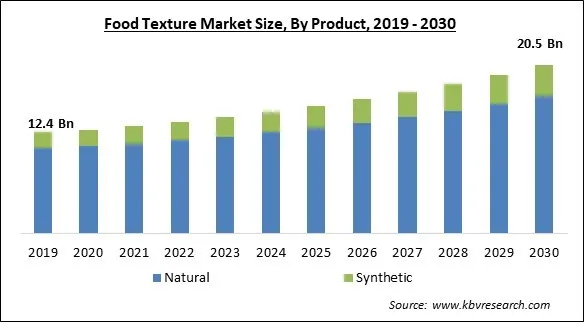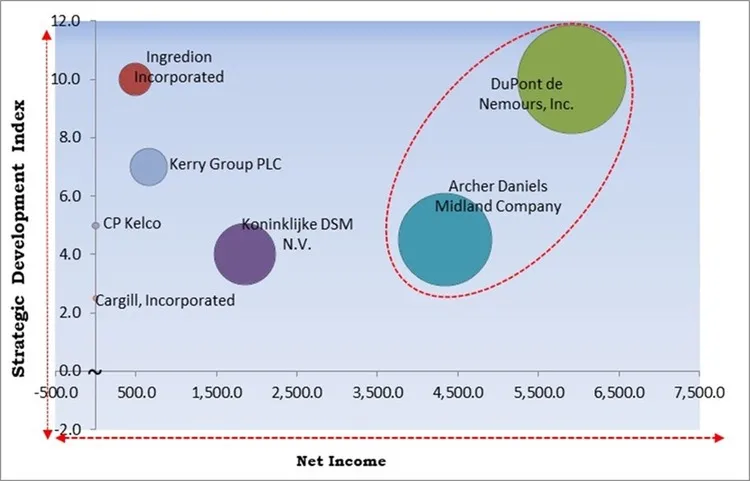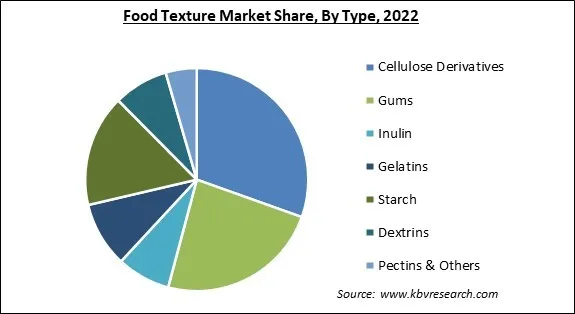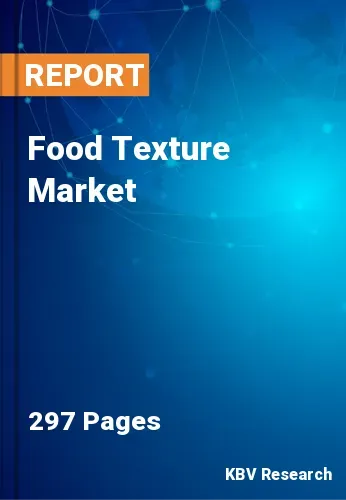The Global Food Texture Market size is expected to reach $20.5 billion by 2030, rising at a market growth of 5.5% CAGR during the forecast period.
Texture-modifying compounds are now being used more frequently in food products because of consumers' increased desire for unique goods with improved nutritional value and texture. The Sauces & Others will capture 1/5th share in the market by 2030, as the texture of sauces and dressings has a significant impact on both the general mouthfeel and consumer satisfaction. The growth of the market in this segment has been driven by the use of thickeners, emulsifiers, and stabilizers to increase the consistency and stability of sauces and dressings. Also, growing use in other applications such as pet food, infant food, and nutritional supplements is anticipated to remain moderate over the forecast period.

The major strategies followed by the market participants are Partnerships as the key developmental strategy to keep pace with the changing demands of end users. For instance, In January, 2023, Cargill Ingredients came into an agreement with Blendtek Ingredients, Inc, to strengthen Cargill's distribution network in Canada with Blendtek’s locally stocked distribution abilities. Additionally, In December, 2022, Kerry signed an agreement with Kameda Seika, to commercialize and supply Kerry’s rice-derived postbiotic entirely in Europe and the Americas in a range of applications.
Based on the Analysis presented in the KBV Cardinal matrix; DuPont de Nemours, Inc. and Archer Daniels Midland Company are the forerunners in the Market. In August, 2022, Archer Daniels Midland partnered with New Culture. Following this partnership, ADM's fermentation and dairy processing operations would help produce New Culture's cheese as the company enhances its commercial presence. Companies such as Ingredion Incorporated, Kerry Group PLC and Koninklijke DSM N.V. are some of the key innovators in the Market.

Convenience food consumption has grown substantially due to rising disposable income and changing consumer lifestyles. Customers are looking for food products that are not only convenient but also healthy and safe as they become more health concerned. On the market for food emulsifiers, new trends and changes in consumer behaviour may also have a significant impact. The market has expanded significantly, partly due to the popularity of convenience foods. The market is anticipated to rise gradually because of this trend in the upcoming years.
Customers throughout the world want products to be more natural and want to consume a lesser amount of sugar. Consumer preference for clear labeling continues influencing protein and sugar reduction options for texture replacement. To reduce prices and make their products more accessible to everyone, firms could utilize texture techniques to enhance the sensory experience. Food texture is crucial when it comes to how customers perceive food & beverages. The ice creams that people prefer mostly to eat have various textures. By including more air in a recipe, this is accomplished. Food texture will remain an important focus throughout the projected period and drive significant market expansion.
Texturizers and food additives can be expensive and changes in the price of raw materials can impact the production cost. In addition, supply chain disruptions and complexity may impact these substances' availability and price. Compounds that are "closer to nature" and more familiar to consumers are being sought after on product labels, with texturizing compounds taking the lead. Due to previous price rises, manufacturers have been attempting to maintain the multiple beneficial characteristics of LBG using less expensive components. The cost and supply chain challenges will cause the market to be constrained.
Based on application, the market is classified into dairy products & ice creams, confectionery, jams, layers, fillings, bakery, ready meals, sauces & others, beverage, and meat products. The bakery segment covered a considerable revenue share in the market in 2022. The texture of these products greatly impacts how they taste overall and how appealing they are to consumers. Bakery products often use texture-improving ingredients like gelling agents, emulsifiers, and thickeners.
On the basis of type, the market is segmented into gums, pectins, gelatins, starch, inulin, dextrins, others, and cellulose derivatives. In 2022, the cellulose derivatives segment dominated the market with the maximum revenue share. Due to growing customer demand for products with clear labels & ingredients derived entirely from nature, the need for cellulose derivatives has expanded. This derivative is a clean-label option for synthetic or chemically altered substances because it is sourced from plant and natural sources.

By product, the market is fragmented into natural, and synthetic. The synthetic segment garnered a significant revenue share in the market in 2022. Food additives used by food companies to improve the mouthfeel and texture of various food products are synthetic food textures. Despite the continuous controversy surrounding their use, synthetic food textures have several potential advantages, including increased stability, texture augmentation, reduced calorie content, etc.
| Report Attribute | Details |
|---|---|
| Market size value in 2022 | USD 13.6 Billion |
| Market size forecast in 2030 | USD 20.5 Billion |
| Base Year | 2022 |
| Historical Period | 2019 to 2021 |
| Forecast Period | 2023 to 2030 |
| Revenue Growth Rate | CAGR of 5.5% from 2023 to 2030 |
| Number of Pages | 297 |
| Number of Table | 454 |
| Report coverage | Market Trends, Revenue Estimation and Forecast, Segmentation Analysis, Regional and Country Breakdown, Competitive Landscape, Companies Strategic Developments, Company Profiling |
| Segments covered | Type, Product, Application, Region |
| Country scope | US, Canada, Mexico, Germany, UK, France, Russia, Spain, Italy, China, Japan, India, South Korea, Singapore, Malaysia, Brazil, Argentina, UAE, Saudi Arabia, South Africa, Nigeria |
| Growth Drivers |
|
| Restraints |
|
Region wise, the market is analysed across North America, Europe, Asia Pacific, and LAMEA. In 2022, the North America region witnessed the largest revenue share in the market. Natural ingredients and clear labels are emphasized in the regional market. Consumers are becoming increasingly concerned about the ingredients used in food and they are still looking for goods with easier-to-read ingredient lists. This has increased demand for natural thickeners, stabilizers, and organic and clean-label texture solutions.
Free Valuable Insights: Global Food Texture Market size to reach USD 20.5 Billion by 2030
The market research report covers the analysis of key stake holders of the market. Key companies profiled in the report include Koninklijke DSM N.V., Archer Daniels Midland Company, Desosen Biochemical (Ordos) Ltd., Ingredion Incorporated, Kerry Group PLC, Jungbunzlauer Suisse AG, CP Kelco, Cargill, Incorporated, DuPont de Nemours, Inc. and Euroduna Food Ingredients Gmbh
By Application
By Product
By Type
By Geography


The Market size is projected to reach USD 20.5 billion by 2030.
Rising consumption of convenience foods are driving the Market in coming years, however, Challenges in the Cost and Supply Chain restraints the growth of the Market.
Koninklijke DSM N.V., Archer Daniels Midland Company, Desosen Biochemical (Ordos) Ltd., Ingredion Incorporated, Kerry Group PLC, Jungbunzlauer Suisse AG, CP Kelco, Cargill, Incorporated, DuPont de Nemours, Inc. and Euroduna Food Ingredients Gmbh
The Natural segment is leading the Market by Product in 2022; thereby, achieving a market value of $16.8 billion by 2030.
The North America region dominated the Market by Region in 2022 and would continue to be a dominant market till 2030; thereby, achieving a market value of $7.1 billion by 2030.
Our team of dedicated experts can provide you with attractive expansion opportunities for your business.

